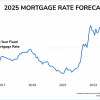
On Thursday, Jun. 6, the European Central Bank (ECB, the eurozone’s equivalent of our Federal Reserve), cut interest rates.
And it wasn’t the first central bank to ease rates. Those in Canada, Sweden and Switzerland have all issued cuts year. The Canadians did so on Jun. 5.
Pressure is building on the Fed to follow suit.
A Fed rate cut could usher in a new era of lower mortgage rates – and other rates like for credit cards and HELOCs. Consumers would be ecstatic.
So, it was no surprise that, very soon after the ECB announcement, The Street published an article under the headline, “ECB's rate cut may force Fed's hand.” But will it?
Why The ECB and Canadian Rate Cuts Are Unlikely To Change The Fed’s Mind
Of course, nothing’s impossible. But there are four reasons why the Fed is unlikely to be swayed by other central banks’ rate policies.
1. The Fed Isn’t Easily Swayed
The Fed is undoubtedly pre-eminent among the world’s central banks. It doesn’t follow trends or bow to peer pressure. It’s not a second-grader in a schoolyard.
Of course, it closely watches other central banks and learns from them. But it seems unlikely that it would feel any pressure to follow suit unless it believed that was the right thing to do for America.
2. The Eurozone Is In a Technical Recession; The U.S. Economy is White-Hot
While there have recently been some signs in the data that the U.S. economy is beginning to weaken a little, we’re a very long way from a recession. Indeed, the May jobs report, published Jun. 7, surprised Wall Street with the labor market’s strength. An eye-popping 272,000 jobs were added to the U.S. economy in May when only 180,000 were expected.
And, if anything, many economists are amazed by just how strong and resilient the economy is.
Contrast that with the eurozone, which comprises the 20 European Union member states that use the euro as their currency. While its gross domestic product (GDP) grew 0.3% in the first quarter of this year, that followed two successive quarters of negative growth, meaning it was in a technical recession.
During those quarters when the eurozone was in recession, GDP in the United States was rising strongly: at a rate of 3.4% in the last quarter of 2023 and a whopping 4.9% in the third quarter.
So, the ECB has been worried about recession and has now chosen to try to stimulate its economy with a rate cut. And the Fed faced the opposite problem: It has been worried that strong growth might fuel inflation.
So, it makes sense for the Fed to want to hold off on rate cuts until it’s confident they won’t overstimulate the economy — no matter how much markets would like early ones.
3. Canada Is Experiencing Lower Inflation, Slower Growth Than The U.S.
The major risk of cutting rates too fast in the U.S. is skyrocketing inflation.
That’s not as much a concern in Canada. Canadian inflation is just 2.7% as of April compared to 3.6% in the U.S. Two percent is the Fed’s goal.
While Canada’s economy is strong, it’s not as fruitful as America’s. Canadians are experiencing a 6.2% unemployment rate to America’s 4.0%, and the “Canadian labour market is trudging along but struggling to meet the needs of a growing number of jobseekers,” says The Canadian Press.
The U.S., on the other hand, has only 0.8 workers for every one available job. In other words, more job openings than workers to fill them.
4. Fed Chair Powell’s Hero Caused Pain and Now Powell is Following Suit
Fed Chair Jerome Powell often references the experience of one of his predecessors, Paul Volker.
During the 1960s and ‘70s, the Fed had made various half-hearted attempts to rein in inflation. But it had not been willing to inflict the economic pain (a recession and high unemployment) that would be needed to achieve that goal.
That changed with Mr. Volker. He hiked rates generally, with mortgage rates peaking at 18.63% in September 1981. And he stuck the course, keeping all rates high for as long as it took to drive excess inflation out of the economy.
The pain he inflicted was enormous and he was deeply unpopular at the time. But his efforts paid off, with the inflation rate tumbling from more than 14% in 1980 and remaining low for decades.
In the following chart, you can see inflation bouncing between 2% and 3% since 2011 until 2021.
Federal Reserve Bank of Cleveland, Median Consumer Price Index [MEDCPIM158SFRBCLE], retrieved from FRED, Federal Reserve Bank of St. Louis, June 5, 2024.
The late Paul Volker is Mr. Powell’s hero. And it’s hard to imagine him backing off high interest rates until he’s convinced the danger of a resurgence in inflation is passed.
Fed cuts are most likely when data suggest the economy is struggling. Cutting general interest rates is a good way to stimulate economies, as the ECB is trying to do now.
And that means weaker data often drag mortgage rates lower. Strong economic data tend to push them upward.
So, Will Mortgage Rates Drop?
John Kenneth Galbraith once famously wrote, “The only function of economic forecasting is to make astrology look respectable.” And the only thing certain about the economy is uncertainty.
Many observers think that will be in the third or fourth quarters of 2024. But we may get a stronger guide when the FOMC next meets on Jun. 12.
It’s highly unlikely that the Fed will be hurried along by other central banks cutting their funds rates.
The Fed, and U.S. mortgage rates, will continue to be highly dependent on the U.S. economy. Don’t expect big mortgage rate improvements based on foreign central bank moves.
Case in point: mortgage rates are moving up today, June 7, 2024, because of the blowout jobs report showing that the economy is still strong, there’s still a labor shortage, and inflation is still a concern. All this in the wake of important central banks cutting their rates.
As a mortgage rate shopper, keep watching, learning, and hoping for the best.



![Federal Reserve Bank of Cleveland, Median Consumer Price Index [MEDCPIM158SFRBCLE], retrieved from FRED, Federal Reserve Bank of St. Louis; https://fred.stlouisfed.org/series/MEDCPIM158SFRBCLE, June 5, 2024.](https://storage.googleapis.com/craftcmsstore001/Images/Median-Consumer-Price-Index.png)

